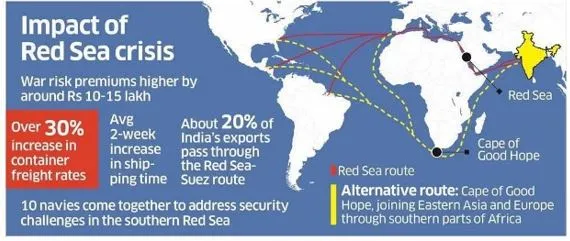

15th June 2024 (10 Topics)
Context
For decades, the U.S. Navy prepared for potential conflicts with major global powers like the Soviet Union, Russia, and China. However, its current focus has shifted unexpectedly to combating Houthi rebels, an Iran-backed group based in Yemen. This conflict has become the most intense ongoing naval battle the Navy has faced since World War II.
Who are the Houthi Rebels?
- The Houthis are an armed political and religious group which champions Yemen's Shia Muslim minority, the Zaidis.
- They declare themselves to be part of the Iranian-led "axis of resistance"against Israel, the US and the wider West - along with armed groups such as Hamas and Lebanon's Hezbollah movement.
- At present, they are targeting Red Sea and adjoining Gulf of Aden.
How could Houthi attacks affect the global economy?
- Disruption of Trade: The attacks have resulted in significant disruptions to shipping in the Red Sea directly affecting global trade flows, particularly those relying on the efficient passage through the Suez Canal.
- Impact on Energy Transit: Approximately 12 percent of seaborne oil and 8 percent of liquefied natural gas (LNG) pass through the Suez Canal, making any disruption in the Red Sea a critical concern for global energy markets.
- Alternative Shipping Routes: Due to the risks associated with the Red Sea route, some commercial ships have opted to circumnavigate the Horn of Africa However, this alternative route entails additional costs estimated at approximately USD 1 million in extra fuel expenses for a round trip.
- Economic Costs: The shift away from the Red Sea route has financial implications beyond fuel costs. Insurance premiums for ships navigating through the Red Sea have surged nearly tenfold since the onset of Houthi attacks, reflecting heightened risks and uncertainties associated with this route.

Red Sea Route
|


